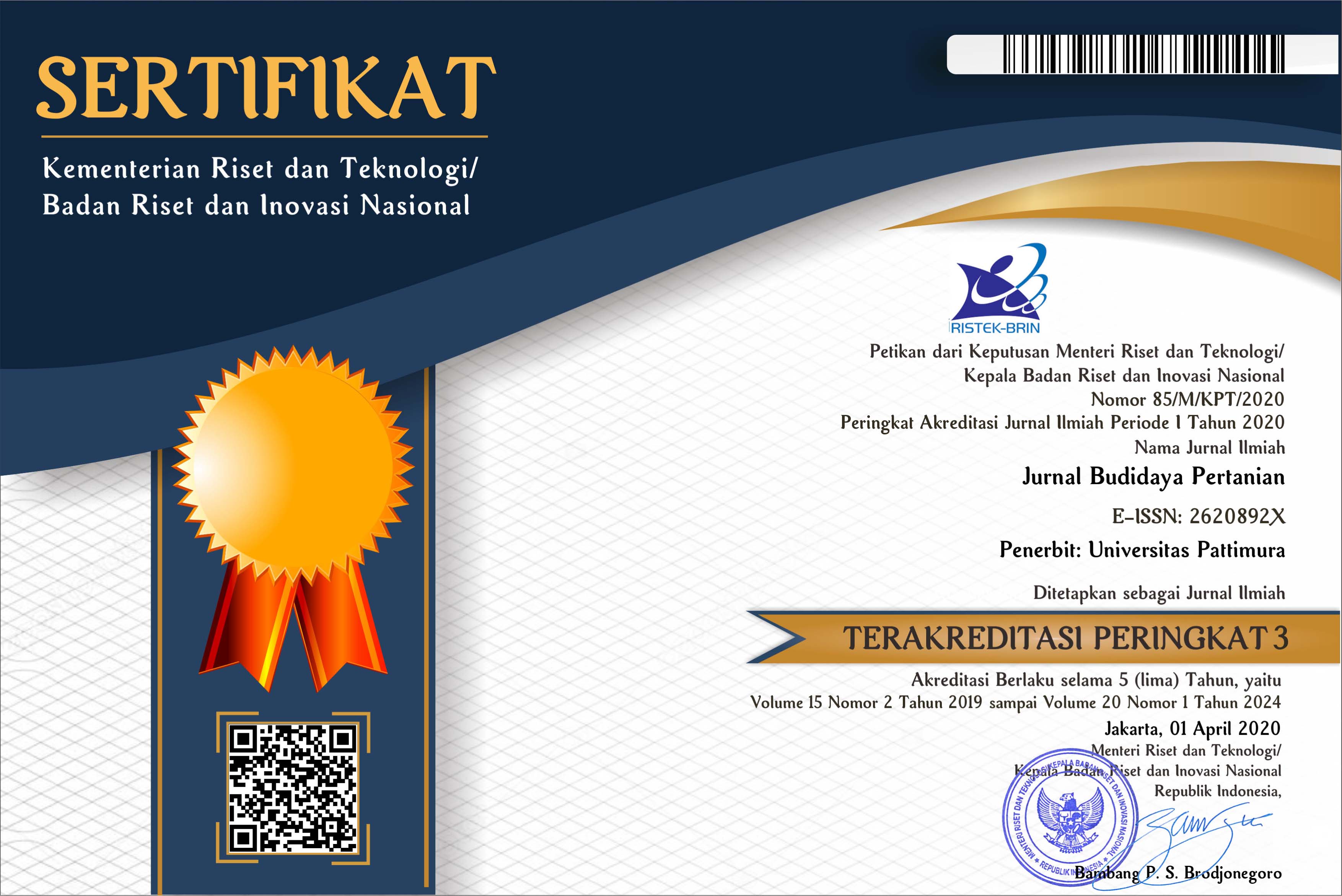KARAKTERISTIK SOSIAL EKONOMI DAN KENDALA PRODUKSI DAN PEMASARAN TERNAK KAMBING LAKOR DI PULAU LAKOR PROVINSI MALUKU
Abstract
This study aims to identify the socioeconomic characteristics of goat breeders and the constraints that affect the production and marketing of Lakor goat livestock as well as policy interventions desired by ranchers on the island of Lakor. The results showed that the characteristics of Lakor goat breeders were low-educated, as the main business, using family labor, most breeders are productive aged, the business scale can reach> 50 tails, the breeding goals are for income, saving and only a small part to obtain organic fertilizer. The production system of Agropastoral management (65.00%) and pastoral (35.00%). Economic analysis shows that the average income per year per breeder Rp. 6.153.750,00 and B/C ratio of 2.14. Production constraint is the decreasing of pasture quality during the dry season, thus it is necessary for technology introduction, extensive maintenance system needs to be changed to semi intensive system, and intensively and no seed selection. This condition needs to be improved to increase production and productivity. Existing sales problem is the weakness of market access and access to financial institutions due to unavailability of marketing support infrastructure and farmers have no guarantee to obtain loans from the Bank. In addition, all respondents wanted government intervention in providing supervisors, availability of production facilities such as medicines and vitamins with low prices, provision of road infrastructure, land transportation facilities and special vessels of livestock. Certification of Lakor goat livestock are important to prevent the extinction of livestock clumps native to Indonesia, maintaining the quality of Lakor goat breeder and Lakor island can be used as a producer area of goat seeds in Indonesia. The role of research institutions including universities is extremely needed in producing technology.
Keywords: Goat Lakor, characteristics of farmers, constraints, government intervention
ABSTRAK
Penelitian ini bertujuan untuk mengindentifikasi karakteristik sosial ekonomi peternak kambing dan kendala-kendala yang mempengaruhi produksi dan pemasaran ternak kambing Lakor serta intervensi kebijakan yang diinginkan oleh peternak di pulau Lakor. Hasil penelitian menunjukkan bahwa karakteristik peternak kambing Lakor adalah berpendidikan rendah, sebagai usaha pokok, menggunakan tenaga kerja keluarga, sebagian besar peternak berusia produktif, skala usaha dapat mencapai >50 ekor, tujuan pemeliharaan untuk pendapatan, tabungan dan hanya sebagian kecil untuk memperoleh pupuk organik, Sitem produksi usaha pengelolaan Agropastoral (65,00%) dan pastoral (35,00%). Analisis ekonomi menunjukkan bahwa rata-rata pendapatan per tahun per peternak Rp. 6.153.750,00 dan B/C ratio sebesar 2,14. Kendala produksi yaitu menurunnya kualitas padang pengembalaan saat musim kemarau sehingga perlu introduksi teknologi, sistem pemeliharaan ekstensif perlu dirubah ke sistem semi intensif, dan intensif dan tidak dilakukannya seleksi bibit. Kondisi ini perlu di lakukan perbaikan untuk meningkatkan produksi dan produktivitas. Kedala pemasaran adalah lemahnya akses pasar dan akses lembaga keuangan karena tidak tersedianya infrastruktur penunjang pemasaran serta peternak tidak memiliki jaminan untuk memperoleh pinjaman dari Bank. Selain itu seluruh responden menginginkan intervensi pemerintah dalam menyediakan tenaga penyuluh, ketersediaan sarana produksi seperti obat-obatan dan vitamin dengan harga yang murah, penyediaan infrastruktur jalan, sarana transportasi darat dan kapal khusus ternak. Sertifikasi bibit kambing Lakor perlu dilakukan untuk mencegah terjadinya kepunahan rumpun ternak asli Indonesia, menjaga kualitas bibit kambing Lakor dan pulau Lakor dapat dijadikan wilayah penghasil bibit kambing di Indonesia. Peran lembaga penelitian termasuk perguruan tinggi sangat dibutuhkan dalam menghasilkan teknologi.
Kata kunci: Kambing Lakor, Karakteristik peternak, kendala, intervensi pemerintah
Downloads
References
Aminah, S. 2015. Pengembangan kapasitas petani kecil lahan kering untuk mewujudkan ketahanan pangan. Jurnal Bina Praja 7: 197-201.
Bettencourt, E.M.V., M. Tilman, V. Narciso, M.L.S. Carvalho, and P.D.S. Henriques. 2014. The role of livestock functions in the well being and development of Timor-Leste rural communities. Livestock Research for Rural Development 26: 1-9.
Dirjen Peternakan dan Kesehatan Hewan Kementerian Pertanian. 2012. Penetapan Rumpun/Galur Ternak Indonesia. Tahun 2010-2011. Jakarta.
Hartono, B. and E.S. Rohaeni. 2014. Contribution to income of traditional beef cattle farmer households in tanah laut regency, south kalimantan, indonesia. Livestock Research for Rural Development 26: 1-8.
Musaba, E.C. 2010. Analysis of factors influencing adoption of cattle management technologies by communal farmers in Northern Namibia. Livestock Research for Rural Development 22: 1 5.
Rege, J.E.O., A.K. Kahi, M. Okomo-Adhiambo, J. Mwacharo, and O. Hanotte. 2001. Zebu Cattle of Kenya: Uses, Performance, Farmer Preferences, Measures of Genetic Diversity and Options for Improved Use. Animal Genetic Resources Research 1. ILRI (International Livestock Research Institute), Nairobi, Kenya. 103 pp..
Oladele, O.I. 2001. Gender analysis of livestock production among enclave dwellers in Ogun State. In: Proc. 6th Conf. Animal Sci. Assoc. Nig., Univ. of Maiduguri: 203-205.
Wibowo, M.H.S., B. Guntor, and E. Sulastri. 2011 Assessment of agribusiness development program implementation of beef cattle farming in sekadau regency, West Kalimantan. Buletin Peternakan 35: 143-153.


 Accreditation is valid for 5 years, starting from Volume 15 Issues 2 December 2019 up to Volume 20 Issue 1 June 2024.
Accreditation is valid for 5 years, starting from Volume 15 Issues 2 December 2019 up to Volume 20 Issue 1 June 2024.






